Vicksburg National Military Park in Mississippi today stretches over 1800 acres worth of ravines, woods, and fields.
Vicksburg National Cemetery is included, which is the resting place of 17,000 soldiers of the Union- this is the highest number of any national cemetery.
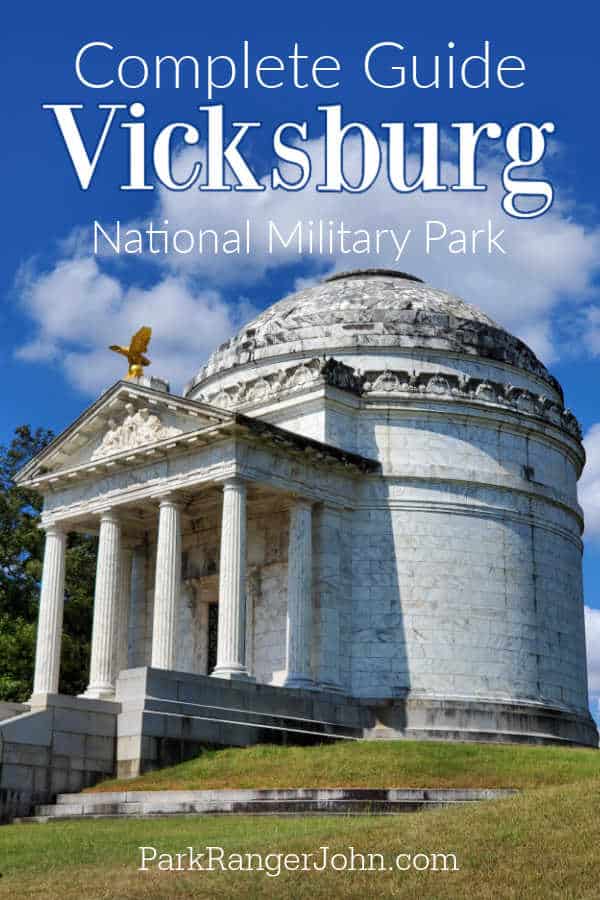
TL;DR Don’t have time to read the full article? Here are my top finds:
🏨Hotels and Vacation Rentals
📍Tours
🐻 Save time! Buy your National Park Pass before your trip
Vicksburg National Military Park
Vicksburg National Military Park commemorates one of the most decisive Civil War battles including the campaign siege and defense of Vicksburg.
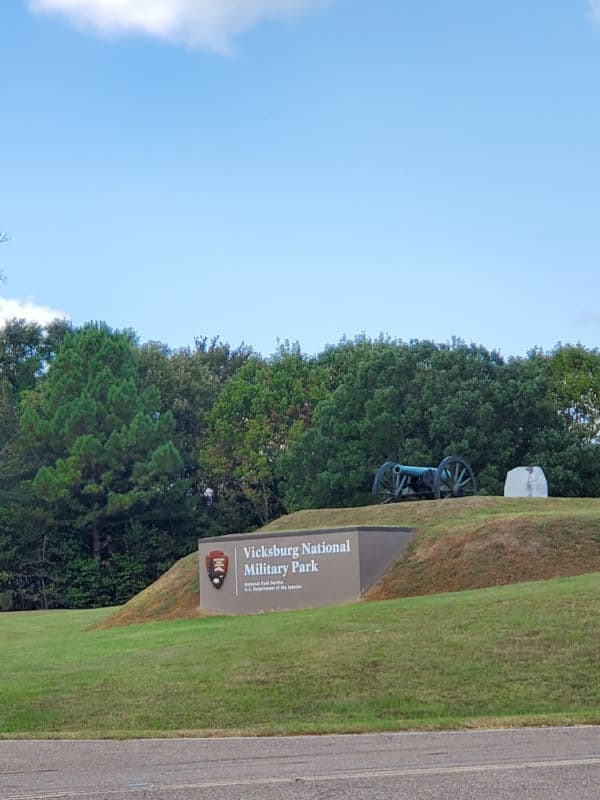
About Vicksburg National Military Park
Vicksburg NMP includes 1,325 historic monuments and markers, 20 miles of reconstructed trenches and earthworks, a 16-mile tour road, antebellum home, 144 emplaced cannon, restored Union gunboat-USS Cairo, and the Vicksburg National Cemetery.
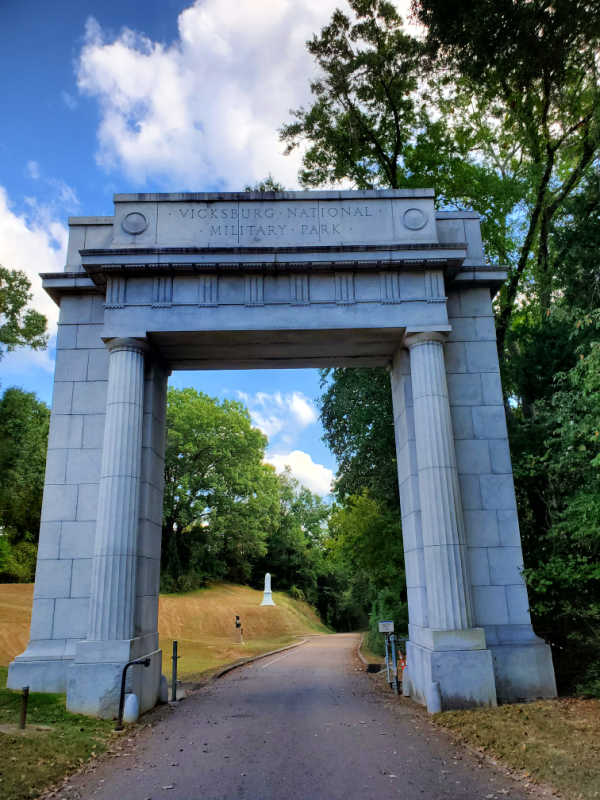
Is Vicksburg National Military Park worth visiting?
Yes, Vicksburg NMP provides visitors the opportunity to learn more about the Civil War battle for control of the Mississippi River.
This National Military Park does a really great job of educating visitors while giving you the opportunity to decide just how deep you want to go in Civil War history.
The USS Cairo is a must-visit and truly awe-inspiring. It is hard to believe that battleships like the USS Cairo were being used in the 1800s.
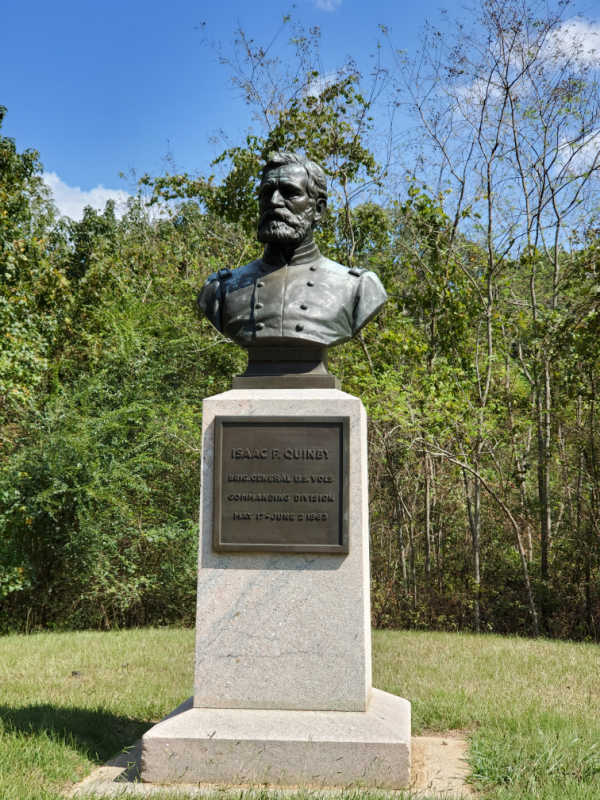
History of Vicksburg National Military Park
Battle of Vicksburg
The Battle of Vicksburg, otherwise known as the Siege of Vicksburg- happened in Mississippi, Warren County.
The Union forces attempted to capture a position, which was strategic, during the Civil War in America.
Abraham Lincoln was the president at the time and he realized the significance of the Vicksburg town, which is located above the Mississippi River, on a 200-foot bluff.
President Abraham Lincoln believed that Vicksburg was the key and that the war wouldn’t end until the key is in their pocket.
Facts about the battle
The Battle of Vicksburg occurred between the dates of the 18th of May and 4th of July, 1863.
The Union General was Ulysses S. Grant and the Confederate General was John C. Pemberton.
Confederate President Jefferson Davis himself referred to Vicksburg as the “nailhead that holds the South's two halves together,”.
The soldiers involved in the battle were 75000 for the Union, and 34000 for the Confederates. The soldiers that lost their lives were 4800 for the Union, and 3300 for the Confederates- with approximately 30000 of their soldiers being captured.
The Union won the battle.
First Battle of Vicksburg
In the summer of 1862, the first attempt to capture Vicksburg occurred. The Union prolonged their bombardment by naval vessels and then when the ships withdrew they sputtered out.
During this occurrence, Major General Ulysses S. Grant moved overland to advance into the town, however the advance was ended early when General Nathan Bedford Forrest tore up the rail supply line with his cavalry, and Major General Earl Van Dorn captured Holly Springs as his supply base.
The efforts made by Major General Ulysses S. Grant continued- with the ultimate goal of seizing Vicksburg.
The efforts continued in December but the efforts continued to fail repeatedly.
There were about 1800 casualties from the Union when the troops of Major General William T. Sherman assaulted against the north of the town, Chickasaw Bluffs.
The troops of Major General Ulysses S. Grant attempted to dig canals over the following months and they also attempted to find ways to get through the “Gibraltar of the West”, which is a narrow and shallow bayou that needed to be bypassed.
The final decision he made was that his army would need to operate on the Southern side of Vicksburg- for this to occur, the navy needed to cooperate.
The next part of the plan entailed the masking of movement from the army, this happened when Sherman conducted two feints on the Northern side of Vicksburg.
Benjamin H. Grierson left on the 17th of April from Tennessee with a cavalry raid right through to Mississippi, which then ended on the 2nd of May when Grierson reached Louisiana, in Baton Rouge.
The raid that was lead by Grierson is known as one of the best cavalry exploits of war.
Then, on the 16th of April, 1863, Admiral David Dixon Porter had a naval fleet come down to Mississippi, which then rendezvoused with the army of Major General Ulysses S. Grant at Hard Times in Louisiana.
This was actually the biggest amphibious operation that has ever been conducted by the American force before World War II.
60 guns and 24,000 men were transferred by Grant and Porter to the east from the west bank.
They ended up at Bruinsburg, Mississippi- they were unopposed and they began to march toward the Grand Gulf and Port Gibson, which are towns found along the riverside.
On the 1st of May, four divisions ended up clashing with a brigade from the Confederates along the Bayou Pierre, which was near Port Gibson.
This caused each side to lose between 700 and 800 soldiers, despite this, the two towns along the river were captured easily.
The remaining army from Grant, that was lead under Sherman, ended up crossing the river at the Grand Gulf. This resulted in his army becoming more than 45000 soldiers, which then went inland to Jackson in Mississippi.
Mississippi Inland Campaign by Grant
The two forces of Confederates in the area included 26,500 soldiers at the garrison of Vicksburg and 5000 soldiers at Jackson. Lieutenant General John C. Pemberton was in-command of Vicksburg, the engineer, and native of Pennsylvania- he had a southern wife but she chose to fight for Confederacy.
There was a collision at Raymond on the 12th of May, with a Confederate brigade and one of Grant’s columns that were advancing.
This occurred a couple of miles on the west of Jackson. After hours of fighting, the southerners retreated, which were lead by General John Gregg.
The next evening there was an arrival at Jackson by the Confederate General Joseph E. Johnston. In May 1862 he was wounded in Virginia at the Seven Pines, so Robert E. Lee took over the defenses of Richmond and was in charge of initiating the Seven Days Battle.
The Department of the West was now being commanded by Johnston and there was an order to Mississippi to counter the threat that was growing.
He realized that the defenses were inadequate, as they were about 6000 men, and ordered them to evacuate.
Gregg’s men fought the following day, however, it was a delayed action and they had to cover the withdrawal.
They then abandoned the capital and the 17 guns to the Federals- who burned most of the town.
Pemberton and Johnston decided that the next best action would be to sever the supply line of Grant to the river of Mississippi.
Pemberton marched with 17500 men to the supply line, leaving 9000 men at the garrison in Vicksburg.
When Pemberton attempted to join Johnston, his men encountered Grant's men that were marching westward- this resulted in the Battle of Champion’s Hill. Pemberton ended up withdrawing as the numbers were overwhelming.
One of the divisions of Major General W. W. Loring got cut off and they were made to turn south and joined the forces of Johnston instead of heading back to Vicksburg.
On the 17th of May came the next clash at the Big Black River Bridge. General Michael Lawler's had his federal troops exploit a weakness in the strong southern position.
Pemberton’s men ended up returning to Vicksburg, the original number of between 20,000 and 25,000 reduced significantly to about 5,000. When including the garrison that was left behind, the force was about 30,000 men in total.
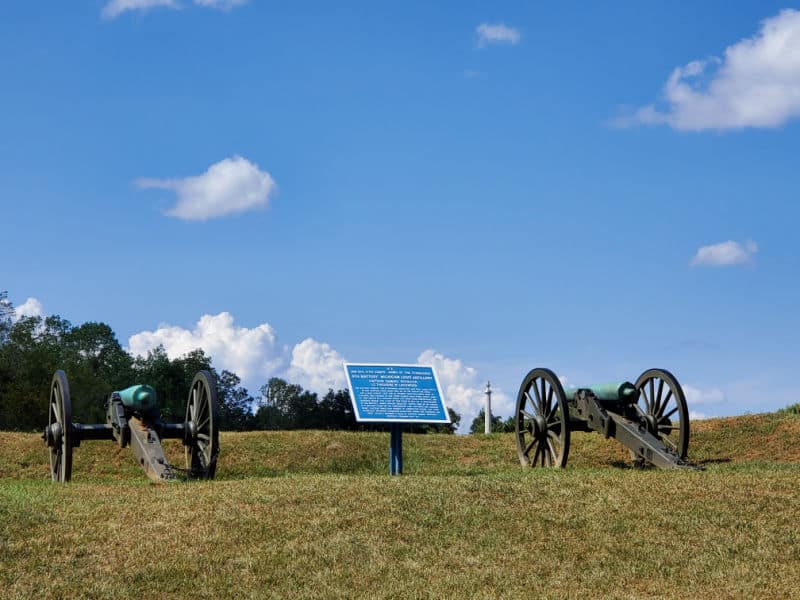
Battle of Vicksburg
Grant hoped to have a quick victory over an already defeated foe on the 19th of May. Grant ordered Sherman’s men to attack the northeastern part of the town along Graveyard Road.
However, the engineer Pemberton had a number of strong works around the town of Vicksburg.
This resulted in the Federals being repulsed by the Stockade Redan defenders, resulting in 1,000 casualties.
Coordinated assaults ended up being made three days later, with Sherman being along the Graveyard Road, and Jackson Road being hit by Major General James McPherson in the center.
The south lines of Southern Railroad and Baldwin Ferry Road of Mississippi were hit by Major General John McClernand- the Railroad Redbout was briefly penetrated by the men, however, the result was over 3,000 lost men due to the repulsion of the three columns.
Vicksburg Siege
Grant was convinced by all the losses of the men and the Confederate strong defensive works that he should take Vicksburg by siege- by cutting off the town from all suppliers.
The plan that Grant initiated is still studied today and is used as an example of a classic siege warfare conduction.
When the men were reinforced to over 70,000, they had been digging trenches for weeks that zigged and zagged- but this brought them all closer to their Pemberton's positions.
One of the groups ended up tunneling beneath the Third Louisiana Redan.
On the 25th of June, there were barrels of black powder that were detonated to blast a hole. When the Union soldiers attempted to surge into the breach, they were met with a counterattack.
The attack lasted for hours before the attackers drove out.
And again on the 1st of July, a mine exploded, but there wasn’t a follow-up attack- but Joe Johnson sent a relief force from Jackson to head toward Vicksburg.
However, it was too late and it didn’t play any role in the fighting.
The civilians of Vicksburg were hiding in caves so that they could avoid the cannon shells that were being fired by Grant’s artillery and the guns that are on the fleet in the water.
Their other supplies had been cut off from the outside for nearly two months, including food.
The soldiers and civilians ended up eating rats, horses, cats, and dogs.
On the 3rd of July Grant was approached by Pemberton who rode to him to discuss terms regarding surrendering. An agreement was eventually reached to parole the men of Pemberton.
Then, on the 4th of July, the Confederate soldiers stacked their guns and began marching out.
Vicksburg didn’t celebrate the 4th of July until finally reaching the 20th century.
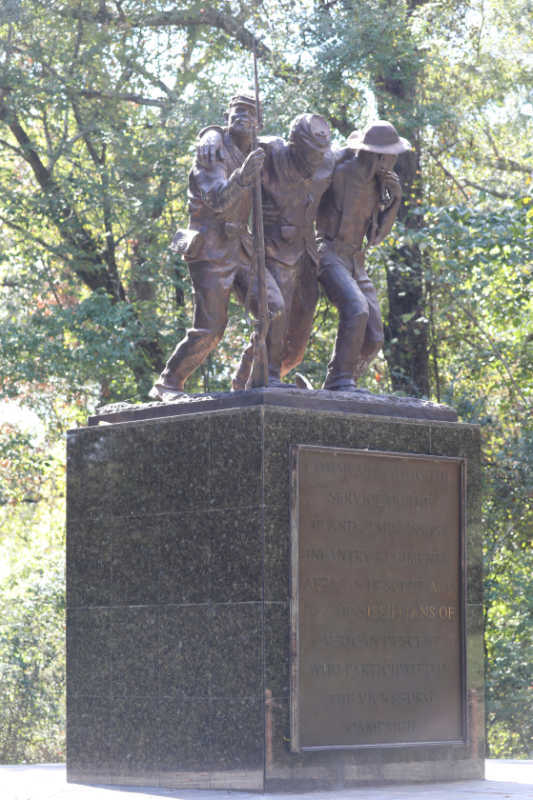
Dedicated February 14, 2004
Vicksburg Aftermath
Port Hudson ended up also capitulating after the fall of Confederate Gibraltar- it was the last stronghold of Mississippi.
Again, on the 4th of July, the army of Robert E. Lee retreated toward Virginia after they were defeated in the Battle of Gettysburg.
The result being Arkansas and Helena falling to the Union and then General William S. Rosecrans ended up forcing the Confederates to withdraw from the middle of Tennessee to the north side of the Georgia state line, in Chattanooga.
There was an irretrievable division of the Confederacy to the east and west.
Pemberton ended up realizing that the Confederate government no longer trusts him with high commands and he ended up resigning from his commission and he tried to enlist as a private.
The southern confederate president Jefferson Davis ended up commissioning Pemberton as a lieutenant colonel of the artillery.
There was an attempted hold on Jackson by Joseph Johnston, however, the Federals ended up reoccupying it- but the damage was already done.
The destruction was so bad that it gained the name “Chimneyville”, which was literally all that was left.
The army of Tennessee was then lead by Johnston during a majority of the Atlanta Campaign as well as after the debacle that occurred at Nashville and Franklin during the Winter of 1864.
His army then surrendered near Bentonville, North Carolina to Sherman- this happened days after the surrender of the army by Robert E. Lee of Northern Virginia.
By the next Summer, Grant became in command of all the Union armies that were in the field- thanks to his reputation, winning tough battles and being cemented at Vicksburg.
However, he did regret his decision to parole the garrison in Vicksburg.
Most of the men ended up re-enlisting and weren’t exchanged for Union prisoners, this put back thousands of rifles into the southern ranks.
Due to this, Grant halted the exchanges of prisoners after his promotion to command all the armies- this decision did shorten the war, but it also condemned thousands of prisoners, which ended up prolonging their incarceration.
Many of them died due to the unsanitary conditions and the overcrowded war camps.
If you want to learn more about the Battle of Vicksburg these books are available on Amazon.
The Complete Civil War Road Trip Guide: More than 500 Sites from Gettysburg to Vicksburg
Vicksburg: Grant's Campaign That Broke the Confederacy
Under Siege!: Three Children at the Civil War Battle for Vicksburg
The Greatest Civil War Battles: The Vicksburg Campaign
The Guide to the Vicksburg Campaign
When was the Battle of Vicksburg?
Siege of Vicksburg: May 23-July 4, 1863.
Who won the battle at Vicksburg?
General John C. Pemberton and the Confederate Army surrendered to General Ulysses S. Grant's Union forces on July 4, 1863.
When did Mississippi secede from the Union?
Mississippi voted for secession on January 9, 1861.
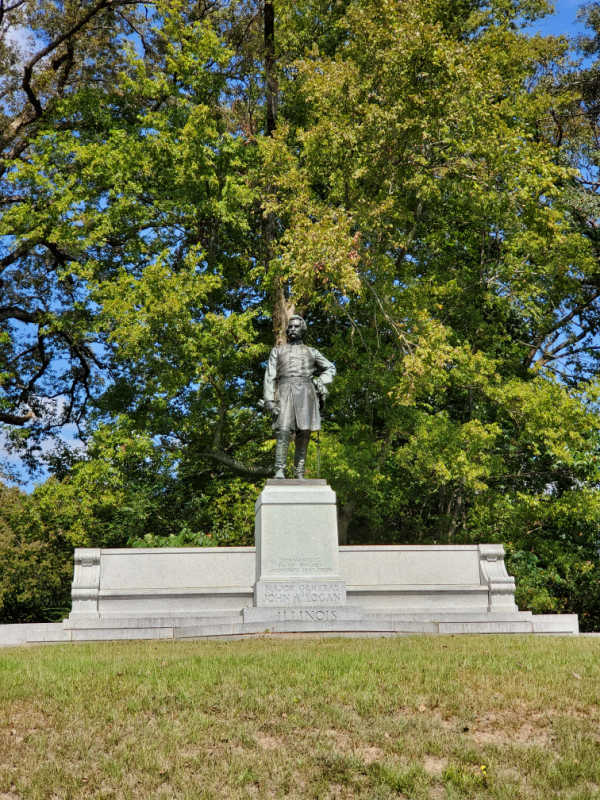
Location: Union Avenue, east of Shirley House
Things to know before your visit to Vicksburg National Military Park
Entrance fee
7-day single-vehicle park pass - $20
7-day individual park pass - $10
7-day motorcycle park pass - $15
Annual Park Pass - $35
Valid for one year through the month of purchase. Admits one private, non-commercial vehicle or its pass holder.
Learn more about National Park Passes for parks that have an entrance fee.
$80.00 - For the America the Beautiful/National Park Pass. The pass covers entrance fees to all US National Park Sites and over 2,000 Federal Recreation Fee Sites for an entire year and covers everyone in the car for per-vehicle sites and up to 4 adults for per-person sites.

Buy your pass at this link, and REI will donate 10% of pass proceeds to the National Forest Foundation, National Park Foundation, and the U.S. Endowment for Forestry & Communities.
National Park Free Entrance Days -Mark your calendars with the five free entrance days the National Park Service offers annually.
Time Zone
CST - Central Standard Time
Pets
Pets must be restrained on a leash no longer than 6 feet.
Vicksburg has a great B.A.R.K. Ranger program you can complete with your pet.
Ticks are prevalent in Vicksburg NMP, especially in late spring through early fall. Check yourself and your dog thoroughly after a visit to the park to prevent any ticks from latching on to you or your dog.
Cell Service
We had really good service while visiting the park with T-Mobile
Park Hours
Park grounds are open from 8 am to 5 pm daily with the last vehicle entry at 4:40 pm.
The USS Cairo Gunboat Museum is open Thursday-Sunday from 8:30 AM till 4:30 PM.
Park Roads are open to pedestrians and bicyclists from sunrise to sunset.
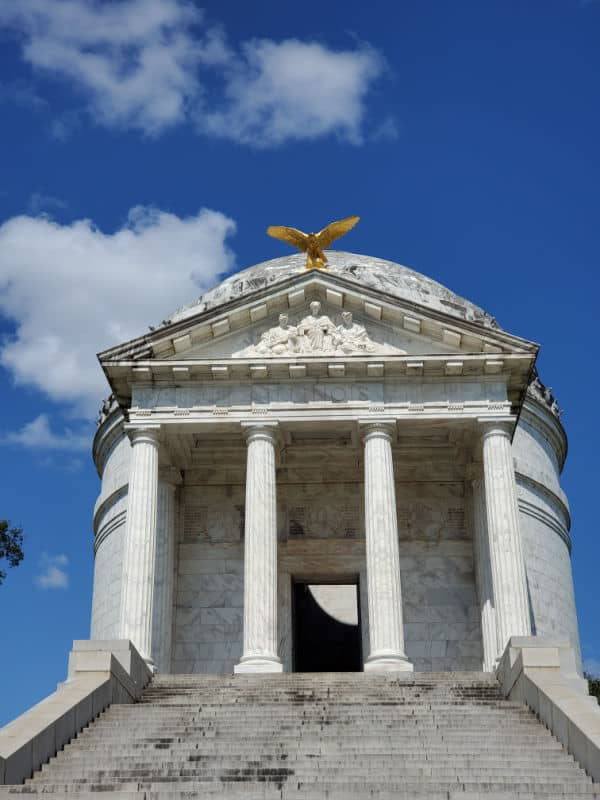
Dedicated on October 26, 1906
Sculptor Charles J. Mulligan
There are forty-seven steps in the long stairway, one for each day of the Siege of Vicksburg.
Insect Repellent
Insect repellent is always a great idea when outdoors, especially if you are around any body of water.
We use Permethrin Spray on our clothes before our park trips
Water Bottle
Make sure to bring your own water bottle and plenty of water with you. Plastic water bottles are not sold in the park.
Food/Restaurants
There are no restaurants within the park.
The closest restaurants are located in Vicksburg, Mississippi
Gas
There are no gas stations within the park.
The closest gas stations are located in Vicksburg, MS
Drones
Drones are not allowed to be used within the boundaries of Vicksburg NMP.
National Park Passport Stamps
National Park Passport stamps can be found in the visitor center.
We like to use these circle stickers for park stamps so we don't have to bring our passport book with us on every trip.
The National Park Passport Book program is a great way to document all of the parks you have visitied.
You can get Passport Stickers and Annual Stamp Sets to help enhance your Passport Book.
Vicksburg NMP is part of the 1987 Stamp Set for the National Park Passport Books.
Electric Vehicle Charging
EV Chargers are available in Jackson, Mississippi.
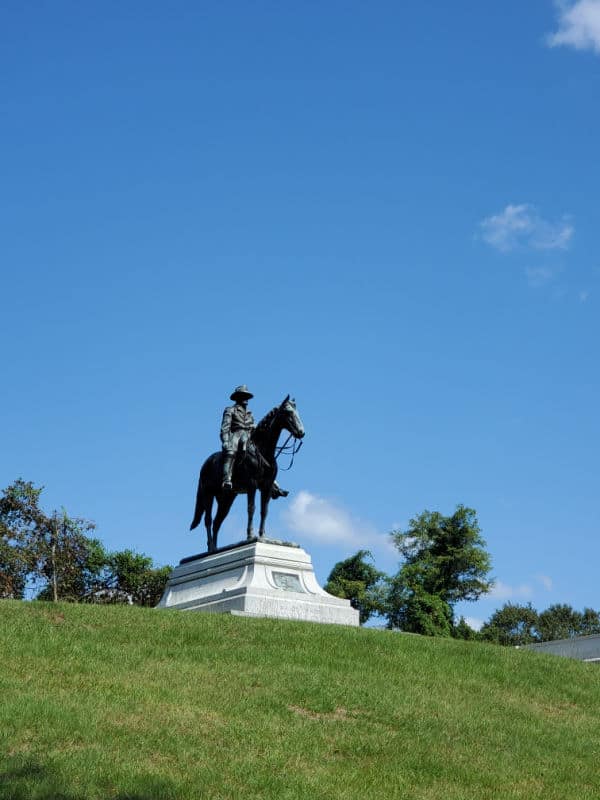
Sculptor: F.C. Hibbard, Erected: 1918, Location: Grant Circle
Details about Vicksburg National Military Park
Size
Vicksburg National Military Park — 1,728 acres
Vicksburg National Cemetery — 116 acres
Check out how Vicksburg NMP compares to National Parks by Size.
Date Established
Vicksburg National Military Park was established on February 21, 1899, as the fifth national military park created by Congress.
Ownership was transferred from the U.S. Department of War to the U.S. Department of the Interior on August 10, 1933.
It is the eighth oldest national park in the United States.
Vicksburg National Military Park Address
3201 Clay Street
Vicksburg, MS 39183-3469
USA
Vicksburg National Military Park Map
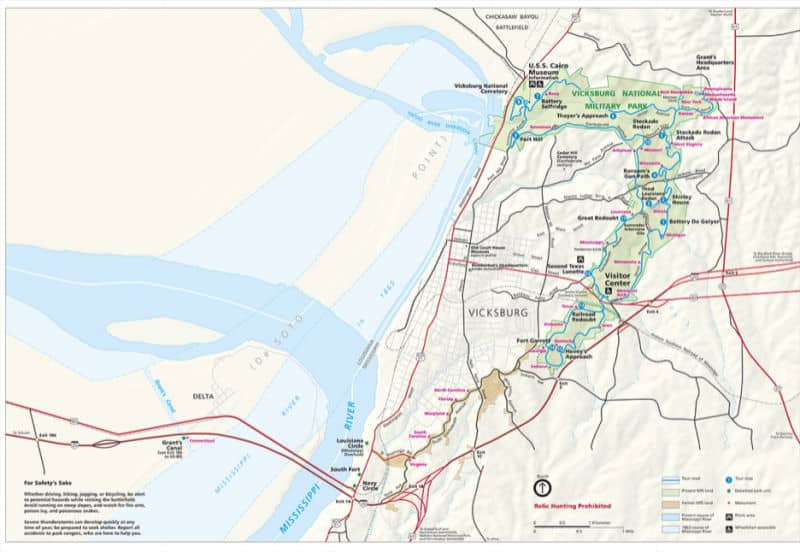
Where is Vicksburg National Military Park?
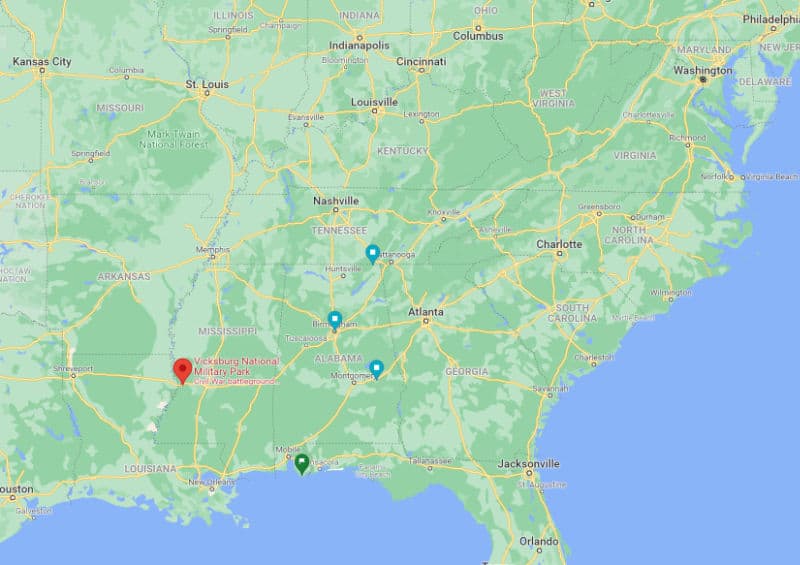
Vicksburg NMP is located in west-central Mississippi near the border with Louisiana.
Warren County, west-central Mississippi, and Madison Parish, northeast Louisiana (Grant's Canal site).
Estimated distance from major cities nearby
Baton Rouge, LA. - 133 miles
New Orleans, LA. - 172 miles
Memphis, TN. - 199 miles
Birmingham, AL. - 251 miles
Houston, TX. - 318 miles
Dallas, TX. - 347 miles
Nashville, TN - 356 miles
Estimated Distance from nearby National Park
Hot Springs National Park - 267 miles
Great Smoky Mountains National Park - 576 miles
Mammoth Cave National Park - 545 miles
Shenandoah National Park - 876 miles
New River Gorge National Park - 810 miles
Where is the National Park Visitor Center?
The visitor center is located at the main entrance to the park.
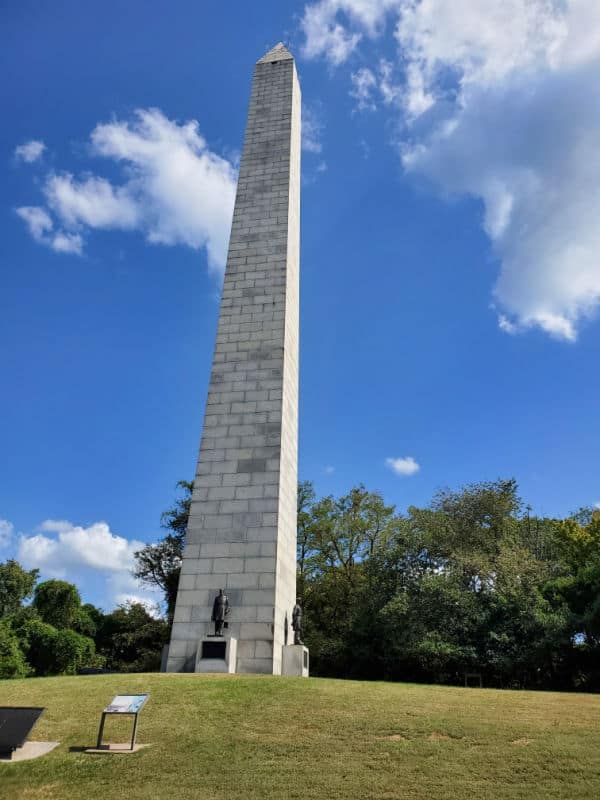
At the base of the monument are four statues of the fleet commanders, Admirals Farragut and Porter, and Flag Officers Davis and Foote.
Getting to Vicksburg National Military Park
Closest Airports
Jackson, MS, 50 miles
International Airports
Louis Armstrong New Orleans International Airport (MSY) - 195 miles
Memphis International Airport (MEM) - 239 miles
Regional Airports
Baton Rouge Metropolitan Airport - 141 miles
Driving Directions
From the East — Take Interstate 20 west to Vicksburg, MS. Use exit ramp 4B. Follow Clay Street (US-80) west 0.25 miles to the park entrance.
From the North — Take Interstate 55 south to Jackson, MS. To save time, use the Interstate 220 bypass on the west side of Jackson.
Take Interstate 20 west to Vicksburg approximately 40 miles. Use exit ramp 4B. Follow Clay Street (US-80) west 0.25 miles to the park entrance.
From the South — Take Interstate 55 or US Highway 49 to Jackson, Mississippi. Take Interstate 20 west to Vicksburg, Mississippi, (approximately 40 miles). Use exit ramp 4B. Follow Clay Street (US-80) west 0.25 miles to the park entrance.
From the West — Take Interstate 20 east to Vicksburg, Mississippi. Use exit ramp 4B. Follow Clay Street (US-80) west 0.25 miles to the park entrance.
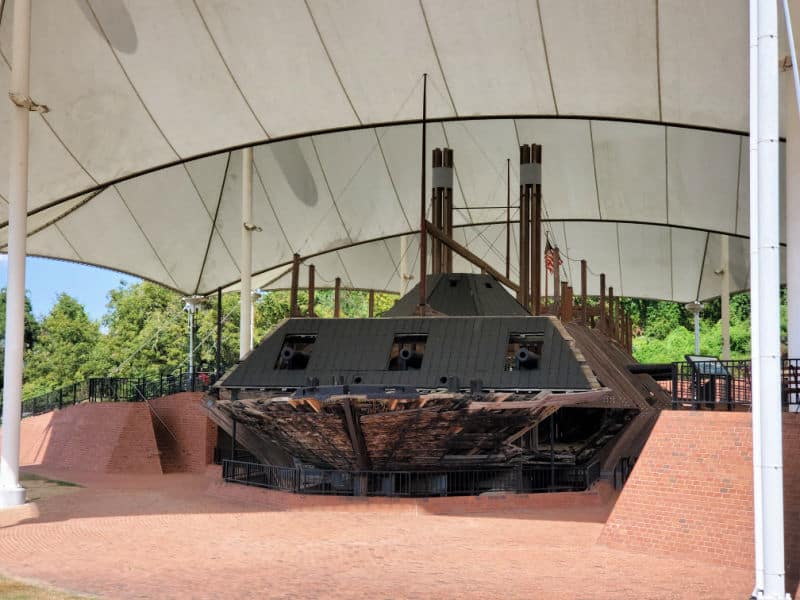
Best time to visit Vicksburg National Military Park
Fall and winter are great times to visit the park. You can escape the hot humid weather of summer and enjoy the pleasant temperatures found during fall and winter.
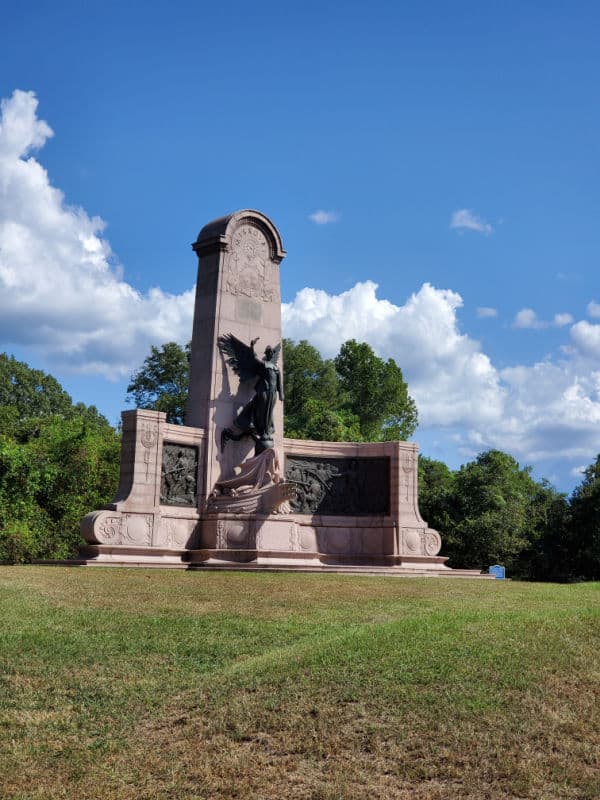
It stands where two opposing Missouri regiments clashed in battle.
The sculptor was Victor S. Holm. Dedicated on October 17, 1917, during the National Peace Jubilee.
Vicksburg National Military Park Weather and Seasons
Summers in Vicksburg are hot, humid, and did I mention HOT!
Fall and winter are great times to visit the park. It is worth noting that Vicksburg does get an average of 57 inches of rain a year so you will want to double-check the weather forecast before you visit.
Vicksburg does not get snow very often which makes it a great park to visit in the winter.
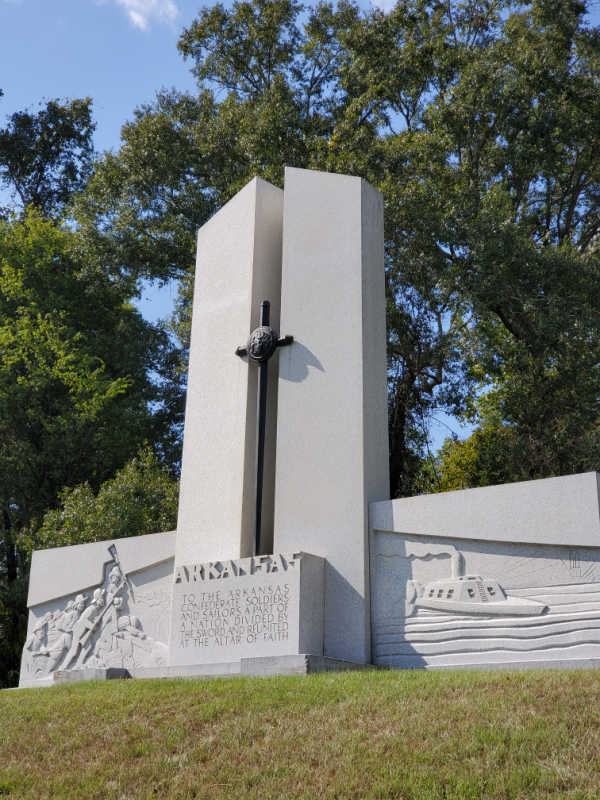
Dedicated on August 2, 1954
Best Things to do in Vicksburg National Military Park
There are quite a few things to do while visiting Vicksburg NMP. We suggest planning at least a half-day if not a full day to visit the park to see everything.
Visitor Center
The visitor center is the perfect place to start your visit. Make sure to grab your National Park Passport stamp while in the visitor center.
There is a great gift shop with souvenirs and great books.
We highly suggest using the restroom before heading out on the auto tour! The next restroom you will encounter is at the USS Cairo Museum at the other end of the park.
You can visit the park store online to purchase Vicksburg NMP products.
16 Mile Auto Tour
The auto tour is divided between Union Avenue and Confederate Avenue. There are 15 stops along the auto tour.
Make sure to grab a park map at the visitor center that explains the importance of each stop along the tour.
Along the route, you will see multiple Vicksburg Monuments and Informational metal tablets.
These tablets describe the troop placement and movement during the battle in this location.
Stops along the auto tour include:
Stop 1 - Battery De Goyler
Stop 2 - Shirley House
Stop 3 - Third Louisiana Redan
Stop 4 - Ransom's Gun Path
Stop 5 - Stockade Redan Attack
Stop 6 - Thayer's Approach
Stop 7 - Battery Selfridge
Stop 8 - Vicksburg National Cemetery
Stop 9 - Fort Hill
Stop 10 - Stockade Redan
Stop 11 - Great Redoubt
Stop 12 - Second Texas Lunette
Stop 13 - Railroad Redoubt
Stop 14 - Fort Garrott
Stop 15 - Hovey's Approach
Cell Phone Driving Tour
Dial a specified number at each tour stop and hear a brief 30-second description of the site's significance.
There are signs at each designated stop with information on what number to call.
Vicksburg Monuments
Over 1,350 monuments, plaques, tablets, and markers can be found within the park.
You can see a large number of monuments along the scenic drive.
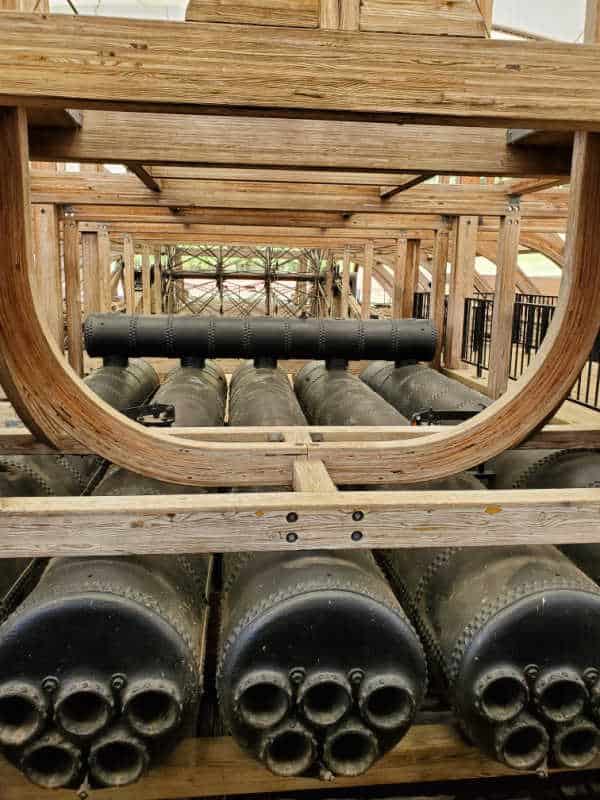
USS Cairo and Museum
The USS Cairo was sunk by a Confederate torpedo (mine) on December 12, 1862, in the Yazoo River, 13 miles north of Vicksburg.
It was located and identified in 1956 and raised on December 12, 1964.
You can walk around the partially restored USS Cairo to see how the 175-foot ironclad warship was built.
There are fantastic interpretive panels explaining how the ship sailed and how it was sunk.
Vicksburg National Cemetery
Vicksburg National Cemetery holds the remains of 17,000 Civil War Union soldiers, a number unmatched by any other national cemetery.
At Vicksburg National Cemetery, 75% of the Civil War dead are listed as unknowns.
No one of national fame is buried in Vicksburg National Cemetery, with Brevet Brig. Gen. Embury D. Osband qualified as the highest-ranking veteran interred (Grave #16648, Section O).
Ranger Programs
Multiple Ranger programs are offered throughout the year primarily in the summer.
Programs include a Ranger's Choice Talk, USS Cairo Gunboat Talks, and Shirley House (Once it opens from rehabilitation).
All programs are free of charge.
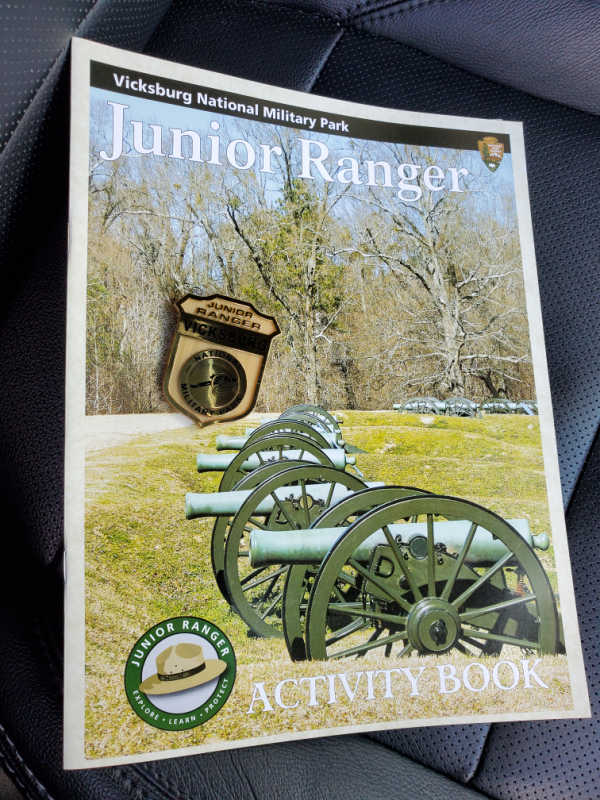
Junior Ranger Program
The Junior Ranger Program can be picked up at the visitor center or at the U.S.S. Cairo Museum.
The Junior Ranger program is a great way for visitors of all ages to learn more about the park.
We have done over 150 Junior Ranger programs and find that we learn something new each time we complete one.
Living History Programs
Historic weapons firing demonstrations and living history programs begin on Memorial Day weekend and conclude on Labor Day weekend. All events are staff and weather-dependent.
All events are free to the public.
Programs include cannon demonstrations, musket demonstrations, and living history historians in costume.
The park also has a 4th of July event celebrating the anniversary of The Surrender of Vicksburg.
Licensed Battlefield Guides
If you want to really dive deep into the history of the battlefield you can hire a licensed battlefield guide.
Tours are approximately two hours in length and can be arranged for individuals, families, and groups of all sizes.
Guides must ride in the visitor's vehicle as they are not permitted to provide transportation services.
All guides have undergone an extensive credentialing and examination process prior to earning their license and are the local experts on the Civil War at Vicksburg.
Reservations are strongly encouraged, but walk-up tours are usually available.
- For Group Tours: Call 1-800- 221-3536
- For Individual/Car Tours: Call (601) 636-3827
Wildlife viewing
The parklands along the Mississippi migratory flyway have led to Vicksburg NMP being designated an Important Bird Area.
The park provides a haven for not only threatened and rare bald eagles and warblers, but also reptile and plant species.
Some of the oldest second-growth trees in the state of Mississippi are found in the park.
Bird watching in the park is fantastic. Some of the species you may see include the Prothonotary Warbler, Eastern Bluebirds, Summer Tanagers, Mississippi Kite, and Eastern Kingbirds.
There is a great Birds of Mississippi Book if you want help identifying birds during your visit.
Additional Park Sites
There are a few park sites not on the main grounds of the park.
Grant's Canal
Located in Madison Parish, Louisiana
This is the location where federal troops tried to cut a canal across the base of De Soto Point so gunboats could bypass Confederate batteries in Vicksburg.
Pemberton's Headquarters
Confederate Lt. General John C. Pemberton's military headquarters were in the Willis-Cowan House. This is the location he decided to surrender Vicksburg to Union forces on July 4, 1863.
Louisiana Circle
From this location Confederate cannon guarded the river approaches to Vicksburg. They engaged Union Gunboats during the siege.
South Fort
This location was the southern anchor of the Confederate defense lines around Vicksburg that guarded the Warrenton Road entrance.
Navy Circle
At this location mounted rifled cannons prevented Confederate escape via the Warrington Road at this southern anchor of the Union siege lines.

Hiking in Vicksburg National Military Park
Always carry the 10 essentials for outdoor survival when exploring.
The Tour Road offers up to a 16 miles pedestrian experience and allows for pedestrians to create walking loops that range in length from 3 miles to 16 miles.
The tour road features a "walkers lane" on the left side of the road as a dedicated lane for non-motorized transportation.
Al Scheller Hiking Trail
Large portions of the Al Scheller Hiking Trail are currently off-limits.
This trail passes through the interior of the park. Parts of it are maintained but you will want to ask at the visitor center about the current trail status.
Be sure to ask for a Vicksburg Trails Orientation Booklet, and learn about the awards to can earn through the Vicksburg Trails Commission.
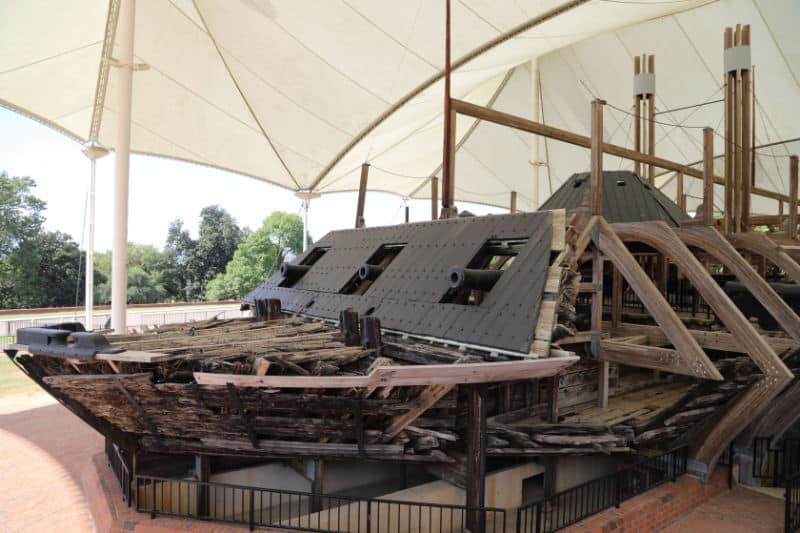
Tours at Vicksburg National Park
Vicksburg Battlefield Self-Guided Driving Tool
⭐️ Rating: 4.2 out of 5 Stars | ⏳ Tour Length: 1-2 hours | 🔊Check Rates and Availability
Bring history to life with this self-guided driving tour of the Vicksburg Battlefield, where Union and Confederate forces fought for control of the Mississippi River. Explore the battlefield and its powerful memorials as you hear about General Grant's march on Vicksburg, the Confederate resistance, and the bloody siege of Vicksburg itself. Revisit tales of bravery, strategy, and grit with dramatic blow-by-blow accounts of the struggle and its nationally altering aftermath.
How to beat the crowds in Vicksburg National Military Park?
The busiest time for Vicksburg NMP is during the summer especially around the anniversary of the battle.
We did not encounter large crowds during our visit to the park. The self-guided auto tour gives you the opportunity to stop when you want to and avoid any crowded areas.
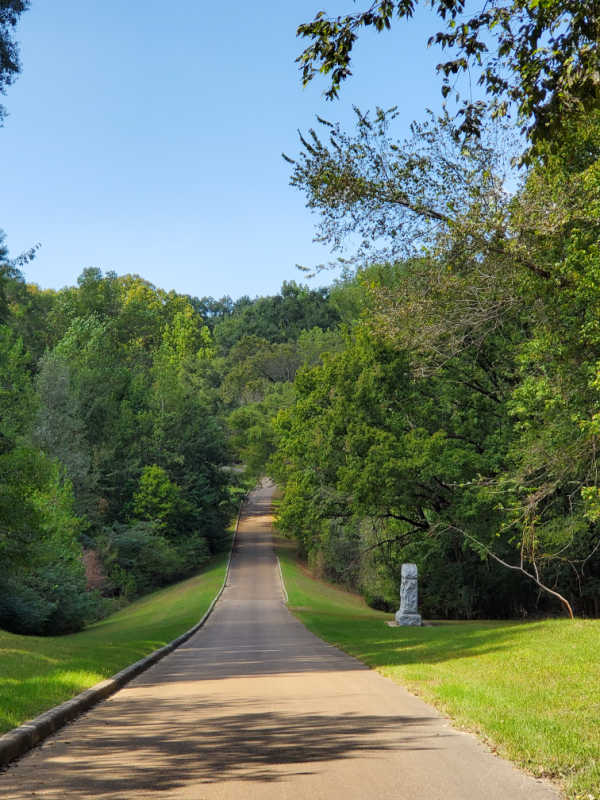
Where to stay when visiting Vicksburg National Military Park
There are no National Park Lodges within the park.
The closest lodging is in Vicksburg and Jackson, Mississippi.
Duff Green Mansion - 4-star bed & breakfast with free full breakfast, a free daily manager's reception, and a terrace at Duff Green Mansion. Stay connected with free in-room Wi-Fi, and guests can find other amenities such as a garden and a library.
Anchuca Historic Mansion & Inn - 3-star hotel with Free full breakfast, a terrace, and a coffee shop/café are just a few of the amenities provided at Anchuca Historic Mansion & Inn. Be sure to enjoy a meal at Anchuca's Garden Room, the onsite restaurant. Free in-room Wi-Fi is available to all guests, along with a garden and a library.
Courtyard Marriott Vicksburg - Take advantage of a firepit, a coffee shop/café, and a garden at Courtyard Marriott Vicksburg. For some rest and relaxation, visit the hot tub. Stay connected with free WiFi in public areas, with speed of 25+ Mbps, and guests can find other amenities such as a library and dry cleaning/laundry services.
Best Western Vicksburg - A free breakfast buffet, 18 holes of golf, and laundry facilities are just a few of the amenities provided at Best Western Vicksburg. Get out on the links at this hotel and enjoy amenities such as golf caddies. Free in-room Wi-Fi is available to all guests, along with a gym and a business center.
Comfort Suites Vicksburg - free self-serve breakfast, dry cleaning/laundry services, and a gym. In addition to a business center, guests can connect to free in-room Wi-Fi.
Click on the map below to find current rates and availability for hotels and vacation rentals near Vicksburg.
Vicksburg National Military Park Camping
There are no campgrounds within Vicksburg NMP.
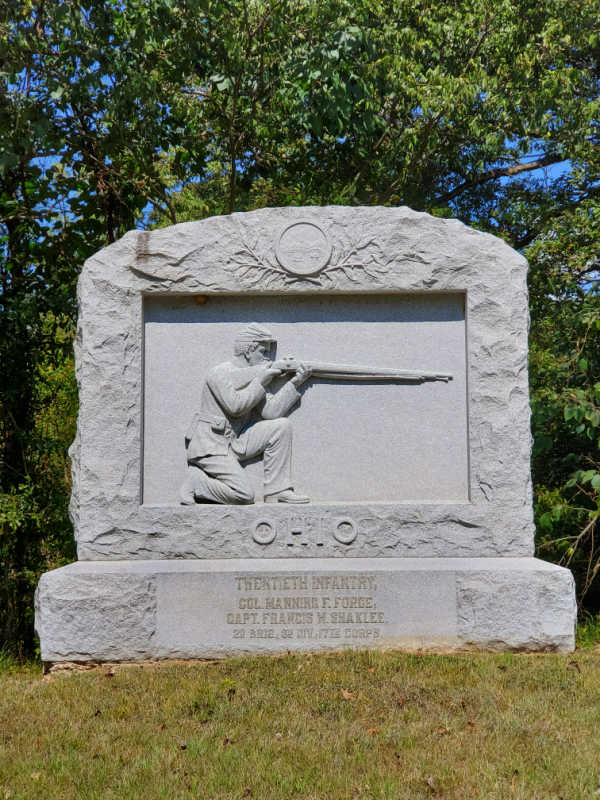
Parks near Vicksburg National Military Park
Poverty Point National Monument
Medgar and Myrlie Evers Home National Monument
Natchez National Historical Park
Cane River Creole National Historical Park
Arkansas Post National Memorial
President William Jefferson Clinton Birthplace Home National Historic Site
Jean Lafitte National Historical Park
Check out all of the National Parks in Mississippi along with neighboring National Parks in Alabama, National Parks in Arkansas, Louisiana National Parks, and Tennessee National Parks.
Check out our Printable List of all 424 US National Park Sites
National Park Service Website
Make sure to follow Park Ranger John on Facebook, Instagram, Pinterest, and TikTok

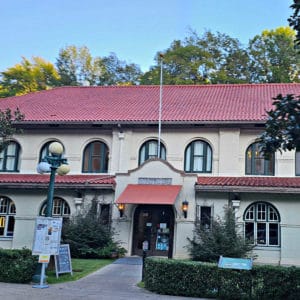
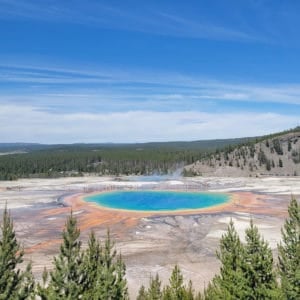

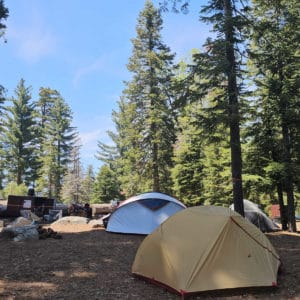
Leave a Reply